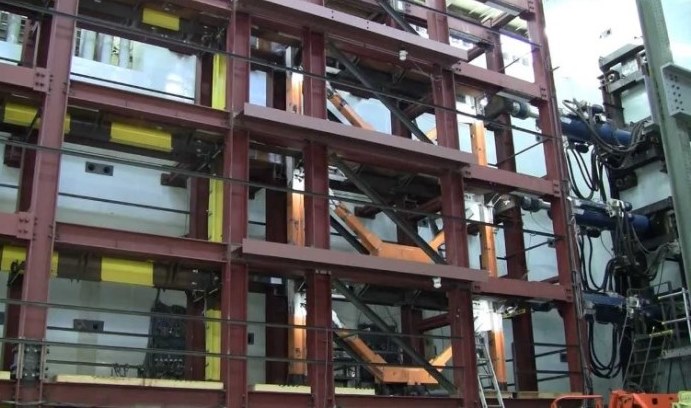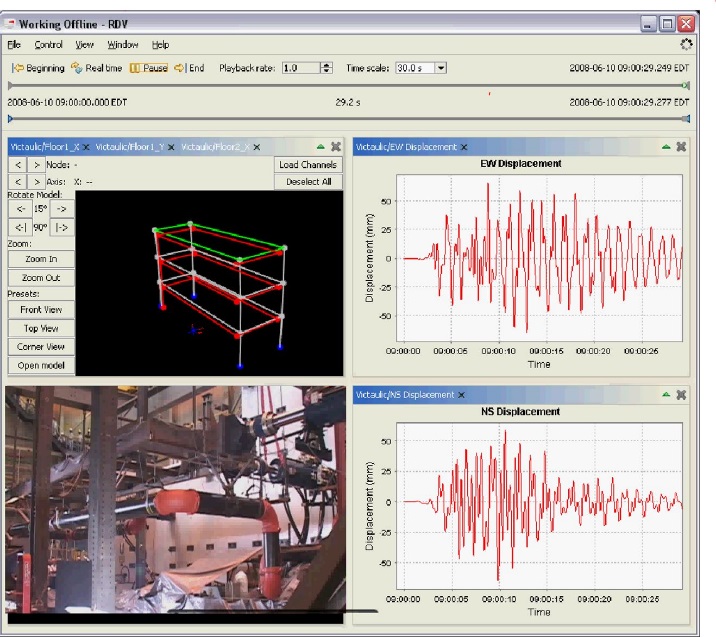Lehigh wins $5M for natural hazards engineering research

The Real-Time Multidirectional testing facilities in Lehigh’s ATLSS Research Center enable researchers to conduct experiments that mimic the demands on structures from earthquakes and other natural disasters.
Lehigh has received a highly competitive grant of $5 million to participate in a national initiative aimed at improving the resiliency and sustainability of the civil infrastructure to better withstand the effects of earthquakes and other natural hazards.
The five-year award from the National Science Foundation (NSF) will support the operation and maintenance to perform research using the unique experimental facilities located in Lehigh’s ATLSS (Advanced Technology for Large Structural Systems) Research Center.
The award is being made through NSF’s $40 million Natural Hazards Engineering Research Infrastructure (NHERI) program, which was launched today.
NHERI will support a network of state-of-the-art shared-use research facilities at seven U.S. universities that will evaluate the performance of engineering designs and materials during earthquakes, hurricanes and other storms, tsunamis, landslides and other disasters.
Lehigh was selected because its ATLSS facilities will enable researchers to conduct real-time, large-scale and multidirectional structural experiments that mimic the demands on structures from natural disasters, said James Ricles, the Bruce G. Johnston Professor of Structural Engineering and Lehigh’s principal investigator (PI) on the NHERI project.
In the ATLSS Center, researchers have also gained extensive experience in performing other types of large-scale experiments that will help NHERI researchers evaluate and confirm the resiliency of structural designs:
• Hybrid simulation (HS), which combines large-scale physical test models with computer-based numerical simulation models;
• Geographically distributed hybrid simulation (DHS), in which the various components of a hybrid simulation are located at different sites while data is transmitted via the Internet and interpreted in real time;
• Real-time hybrid earthquake simulation (RTHS), in which hybrid simulations are conducted at the actual time scale of physical events;
• Geographically distributed RTHS tests;
• Dynamic testing, in which researchers subject large-scale physical models at real-time rates through predefined load histories;
• Quasi-static testing, which loads large-scale physical models at slow rates through predefined load histories.
The NHERI program follows NSF’s George E. Brown Jr. Network for Earthquake Engineering Simulation (NEES) program, which supported earthquake engineering, innovation and education at 15 U.S. universities, including Lehigh, from 2004-2014.
NEES researchers advanced the state of the art in earthquake retrofitting, tsunami preparation, performance-based design and other areas, said NSF officials. The NHERI program will extend these advances to the protection of life and property during severe windstorms.
“NEES research enabled us to better understand and improve soil behavior and the seismic response of structures under earthquake loading through new high-performance construction materials, seismic-resistant structural systems, and ways to strengthen soils to prevent liquefaction,” said NSF program director Joy Pauschke.
“Under NHERI, future discoveries will not only mitigate the impacts of earthquakes, but also will advance our ability to protect life and property from windstorms such as hurricanes and tornadoes.”
Lehigh’s ATLSS Center, which was founded in 1986 with support from NSF, contains some of the largest structural testing facilities in the world. The NEES real-time multidirectional (RTMD) facility allows for hybrid seismic testing and, when combined with real-time numerical simulations, enables researchers to investigate the behavior of large-scale structural components during seismic events.
ATLSS researchers have designed some of the major innovations in earthquake engineering. These include braced frames with passive and semi-active dampers, in addition to self-centering steel, concrete, and timber structures that absorb seismic loads and minimizes earthquake damage to structures.
These advances have contributed to the goal of earthquake engineers in the last half-century, which is not only to eliminate loss of life during earthquakes but also to greatly minimize the property damage and structural “down time” caused by seismic events.
Through the NEES program, Lehigh researchers have also led the way in designing and conducting large-scale real-time hybrid simulation and geographically distributed hybrid simulation experiments.
In one hybrid simulation, researchers subjected a nine-story building to conditions equivalent to those of the Los Angeles-Northridge Earthquake of 1994. They concluded that the building, which was rendered unusable by the earthquake, would not have had to be condemned if it had been fitted with semi-actively controlled magnetorheological dampers.
In an experiment conducted simultaneously at Lehigh, the University of Illinois and Rensselaer Polytechnic Institute, researchers simulated the effects of the Northridge Earthquake on a freeway bridge structural system, including several of its columns and soil-foundation. The goal of that test, which was overseen by Ricles and Richard Sause, ATLSS director and co-principal investigator on the NHERI grant, was to obtain a “holistic” picture of the effect of an earthquake on an entire infrastructure system.
“One goal of the NHERI program is to apply the knowledge gained from conducting research on structural resiliency to earthquakes to the ability of the civil infrastructure to withstand the demand from severe windstorms and other natural hazards,” said Ricles.
In addition to the field of structural engineering, researchers in other fields of engineering and science will benefit from the NHERI program, including geotechnical engineering, hydraulic engineering, lifecycle engineering, mechanical engineering, materials science and computer science.
“In order to successfully perform real-time hybrid simulations of complex systems,” said Ricles, “high-fidelity algorithms are required to control laboratory equipment in real time while simultaneously performing high-speed computations associated with the numerical models.
“While Lehigh has developed and implemented state-of-the-art algorithms over the past decade to conduct hybrid simulations, we will need to continue to develop advanced algorithms using a multidisciplinary approach and high-performance computing. These algorithms will enable researchers to face the many challenges in developing solutions to improve the resiliency and sustainability of the civil infrastructure against different natural hazards.”
For more information, take this virtual tour of the Lehigh NHERI facility.
Posted on:


